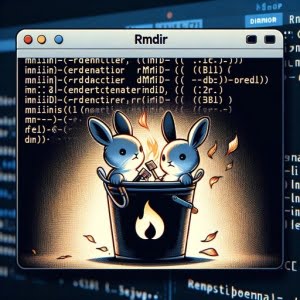Rmdir: The Essential Linux Command for Directory Cleanup

Ever found yourself stuck with unwanted directories in your Linux system? You’re not alone. Many users find it challenging to efficiently remove directories, but there’s a command that can make this task a breeze. Think of the ‘rmdir’ command in Linux as a digital broom, sweeping away unwanted directories and leaving your system clean and organized. It’s an essential tool for any Linux user, from beginners to seasoned system administrators.
In this guide, we’ll walk you through the process of using the ‘rmdir’ Linux command, from basic usage to advanced techniques. We’ll cover everything from removing single directories to deleting nested directories, and even discuss alternative methods and common issues.
So, let’s dive in and start mastering the ‘rmdir’ command in Linux!
TL;DR: How Do I Use the ‘rmdir’ Command in Linux?
The
'rmdir'command is a built-in function in Linux used to remove empty directories. A basic usage would look like this:rmdir [arguments] directory_name.
Here’s a simple example:
rmdir test_directory
# Output:
# (No output if the operation is successful)
In this example, we use the ‘rmdir’ command to remove a directory named ‘test_directory’. If ‘test_directory’ is empty, it will be removed silently without any output. If it’s not empty or doesn’t exist, an error message will be displayed.
This is just a basic way to use the ‘rmdir’ command in Linux, but there’s much more to learn about managing directories efficiently. Continue reading for more detailed information and advanced usage scenarios.
Table of Contents
- Basic Removals with ‘rmdir’
- Advanced Uses of ‘rmdir’
- Alternative Methods for Directory Removal in Linux
- Troubleshooting ‘rmdir’ Issues
- Understanding the Linux File System and Directory Structure
- The ‘rmdir’ Command in System Administration and Scripting
- Exploring Related Commands: ‘mkdir’
- Wrapping Up: Mastering the ‘rmdir’ Command in Linux
Basic Removals with ‘rmdir’
The ‘rmdir’ Linux command is primarily used to remove empty directories. It’s a simple yet effective tool that every Linux user should familiarize themselves with.
Here’s a basic example of how you can use the ‘rmdir’ command:
mkdir test_directory1
echo "Hello, World!" > test_directory1/hello.txt
rmdir test_directory1
# Output:
# rmdir: failed to remove 'test_directory1': Directory not empty
In this example, we first create a directory named ‘test_directory1’. Then, we add a file named ‘hello.txt’ to ‘test_directory1’. When we try to remove ‘test_directory1’ using the ‘rmdir’ command, we receive an error message. This is because ‘rmdir’ can only remove empty directories.
Advantages and Pitfalls of ‘rmdir’
The ‘rmdir’ command is a safe way to remove directories because it only deletes directories that are empty. This can prevent you from accidentally deleting files.
However, this can also be a pitfall if you’re trying to remove a directory that contains files or subdirectories. As shown in the example above, ‘rmdir’ will not remove directories that are not empty.
Advanced Uses of ‘rmdir’
Once you’ve mastered the basic use of the ‘rmdir’ command, you can start to explore its more advanced features. These include removing nested directories, handling error messages, and more.
Before we dive into these advanced uses of ‘rmdir’, let’s take a look at some of the command-line options or flags that can modify the behavior of the ‘rmdir’ command. Here’s a quick reference table:
| Option | Description | Example |
|---|---|---|
-p | Removes directory and its parent directories. | rmdir -p dir1/dir2/dir3 |
--ignore-fail-on-non-empty | Ignores the ‘Directory not empty’ error. | rmdir --ignore-fail-on-non-empty dir1 |
--verbose | Outputs a diagnostic for every directory processed. | rmdir --verbose dir1 |
-v | Same as --verbose. | rmdir -v dir1 |
--help | Displays a help message. | rmdir --help |
--version | Outputs version information. | rmdir --version |
Now that we’re familiar with these options, let’s explore some of the advanced uses of ‘rmdir’.
Removing Nested Directories
One of the most useful features of ‘rmdir’ is the ability to remove nested directories in one command. This can be achieved using the -p option. Here’s an example:
mkdir -p dir1/dir2/dir3
rmdir -p dir1/dir2/dir3
# Output:
# (No output if the operation is successful)
In this example, we first create a nested directory structure with ‘dir1’ containing ‘dir2’, which in turn contains ‘dir3’. We then use the ‘rmdir -p’ command to remove ‘dir3’ and its parent directories ‘dir2’ and ‘dir1’.
Ignoring ‘Directory not empty’ Error
When trying to remove a directory that contains files or subdirectories, ‘rmdir’ will output a ‘Directory not empty’ error. However, you can ignore this error by using the --ignore-fail-on-non-empty option. Here’s an example:
mkdir dir1
echo "Hello, World!" > dir1/hello.txt
rmdir --ignore-fail-on-non-empty dir1
# Output:
# (No output if the operation is successful)
In this example, we create a directory ‘dir1’ and add a file ‘hello.txt’ to it. When we try to remove ‘dir1’ using the ‘rmdir –ignore-fail-on-non-empty’ command, it ignores the ‘Directory not empty’ error, and ‘dir1’ remains intact.
Remember, using these options can make the ‘rmdir’ command even more powerful and flexible. They can help you manage your directories more efficiently and avoid common pitfalls.
Alternative Methods for Directory Removal in Linux
While ‘rmdir’ is an effective tool for removing directories, it’s not the only way to do so in Linux. There are alternative methods that can offer more flexibility, especially when dealing with directories that contain files or subdirectories.
Using the ‘rm’ Command with the ‘-r’ Option
The ‘rm’ command, coupled with the ‘-r’ (or ‘–recursive’) option, can remove directories and their contents recursively. This is particularly useful when you need to delete a directory and all of its contents.
Here’s an example of how to use the ‘rm’ command with the ‘-r’ option:
mkdir dir1
echo "Hello, World!" > dir1/hello.txt
rm -r dir1
# Output:
# (No output if the operation is successful)
In this example, we create a directory named ‘dir1’ and add a file ‘hello.txt’ to it. We then use the ‘rm -r’ command to remove ‘dir1’ and its contents. Unlike ‘rmdir’, ‘rm -r’ does not fail when asked to remove a directory that contains files or subdirectories.
Advantages and Disadvantages
The main advantage of using ‘rm -r’ over ‘rmdir’ is its ability to remove non-empty directories. This can save you the trouble of manually deleting each file or subdirectory before removing the parent directory.
However, this can also be a disadvantage. The ‘rm -r’ command can permanently delete a directory and all of its contents, which can be risky if used improperly. Always double-check your command before pressing enter to prevent accidental data loss.
As with any command, it’s essential to understand what it does and how to use it correctly. Whether you’re using ‘rmdir’ or ‘rm -r’, always make sure you’re deleting the right directories and files.
Troubleshooting ‘rmdir’ Issues
While the ‘rmdir’ command is straightforward, you may encounter some common issues. Understanding these problems and their solutions can help you use ‘rmdir’ more effectively.
Dealing with ‘Directory not empty’ Error
One of the most common issues with using ‘rmdir’ is the ‘Directory not empty’ error. This error occurs when you try to remove a directory that contains files or subdirectories.
Here’s an example:
mkdir dir1
echo "Hello, World!" > dir1/hello.txt
rmdir dir1
# Output:
# rmdir: failed to remove 'dir1': Directory not empty
In this example, we create a directory named ‘dir1’ and add a file ‘hello.txt’ to it. When we try to remove ‘dir1’ using ‘rmdir’, we receive a ‘Directory not empty’ error.
To resolve this issue, you need to ensure the directory is empty before using ‘rmdir’. You can do this by manually deleting the files or subdirectories, or by using the ‘rm’ command with the ‘-r’ option, as discussed in the previous section.
Understanding Permission Issues
Another common issue when using ‘rmdir’ is encountering permission issues. If you don’t have the necessary permissions to delete a directory, ‘rmdir’ will fail.
Here’s an example:
sudo mkdir /root/dir1
rmdir /root/dir1
# Output:
# rmdir: failed to remove '/root/dir1': Permission denied
In this example, we create a directory named ‘dir1’ in the ‘/root’ directory using ‘sudo’, which runs the command as the root user. When we try to remove ‘/root/dir1’ using ‘rmdir’, we receive a ‘Permission denied’ error because we’re not running the command as the root user.
To resolve this issue, you need to ensure you have the necessary permissions to delete the directory. This typically means running the command as the root user or using ‘sudo’.
Remember, while ‘rmdir’ is a powerful tool for managing directories in Linux, it’s essential to understand its limitations and potential issues. By knowing how to troubleshoot these common problems, you can use ‘rmdir’ more effectively and efficiently.
Understanding the Linux File System and Directory Structure
Before diving deeper into the ‘rmdir’ command, it’s crucial to understand the Linux file system and directory structure. This knowledge will provide a solid foundation for understanding how ‘rmdir’ and other directory-related commands work.
The Hierarchical Nature of Linux File System
The Linux file system is hierarchical, starting from the root directory (represented by ‘/’) and expanding into various subdirectories. This tree-like structure organizes files and directories logically and efficiently.
Here’s an example of a basic Linux directory structure:
/
|-- home
| |-- user1
| |-- user2
|-- etc
|-- var
|-- usr
|-- bin
In this example, ‘/’ is the root directory. It contains several subdirectories, such as ‘home’, ‘etc’, ‘var’, ‘usr’, and ‘bin’. The ‘home’ directory further contains subdirectories for different users.
Importance of Directories in Linux
Directories in Linux serve a crucial purpose. They help organize files into different categories for easy access and management. For instance, the ‘etc’ directory typically contains configuration files, while the ‘bin’ directory contains executable programs.
Understanding this structure is vital when using the ‘rmdir’ command. When you remove a directory using ‘rmdir’, you’re not just deleting a name – you’re removing a node in the hierarchical file system. Therefore, it’s essential to ensure that the directory is no longer needed before removing it.
The Role of ‘rmdir’ in the Linux File System
The ‘rmdir’ command plays a crucial role in managing the Linux file system. It allows users to remove unnecessary directories, keeping the file system clean and organized. However, as ‘rmdir’ can only remove empty directories, it encourages careful file management and helps prevent accidental data loss.
In the following sections, we’ll explore more advanced uses of the ‘rmdir’ command in the context of the Linux file system and directory structure.
The ‘rmdir’ Command in System Administration and Scripting
The ‘rmdir’ command is not only a handy tool for everyday Linux users, but it also plays a significant role in system administration and scripting.
System Administration
In system administration, maintaining an organized and clean file system is crucial. The ‘rmdir’ command helps administrators remove unnecessary directories, thus keeping the system tidy and efficient. It’s particularly useful when cleaning up after software uninstallation or user account deletion.
Scripting
In scripting, ‘rmdir’ can be used to automate directory removal tasks. For instance, you might have a script that creates temporary directories during its operation and uses ‘rmdir’ to clean up these directories when the task is complete.
Here’s a simple script that demonstrates this use:
#!/bin/bash
# Create a temporary directory
dir=$(mktemp -d)
# Perform some operation here
# Remove the temporary directory
rmdir $dir
# Output:
# (No output if the operation is successful)
In this script, we first create a temporary directory using the ‘mktemp -d’ command. After performing some operations (which are not shown in this example), we use ‘rmdir’ to remove the temporary directory.
Exploring Related Commands: ‘mkdir’
While ‘rmdir’ is used to remove directories, its counterpart ‘mkdir’ is used to create directories. Understanding both commands is essential for effective directory management in Linux.
Here’s a simple example of how to use the ‘mkdir’ command:
mkdir new_directory
# Output:
# (No output if the operation is successful)
In this example, we use the ‘mkdir’ command to create a directory named ‘new_directory’. If the operation is successful, there will be no output.
Further Resources for Mastering Linux Commands
To deepen your understanding of the ‘rmdir’ command and related topics, consider exploring these external resources:
- GNU Coreutils: rmdir: An in-depth guide to ‘rmdir’ from the maintainers of GNU Coreutils.
Linux Command Library: rmdir: A comprehensive library of Linux commands, including ‘rmdir’.
The Linux Documentation Project: Bash Scripting: A detailed guide to Bash scripting, which can help you automate tasks using ‘rmdir’ and other commands.
Wrapping Up: Mastering the ‘rmdir’ Command in Linux
In this comprehensive guide, we’ve delved into the depths of the ‘rmdir’ Linux command, a powerful tool for managing directories in your Linux system.
We began with the basics, learning how to use ‘rmdir’ to remove empty directories. We then advanced to more complex uses, such as removing nested directories and ignoring the ‘Directory not empty’ error. Along the way, we tackled common issues you might encounter when using ‘rmdir’, such as the ‘Directory not empty’ error and permission issues, and provided solutions and workarounds for each issue.
We also explored alternative methods for directory removal, such as using the ‘rm’ command with the ‘-r’ option. We discussed the advantages and disadvantages of these methods, giving you a sense of the broader landscape of tools for managing directories in Linux.
Here’s a quick comparison of the methods we’ve discussed:
| Method | Pros | Cons |
|---|---|---|
| ‘rmdir’ | Safe, only removes empty directories | Cannot remove non-empty directories |
| ‘rm -r’ | Can remove non-empty directories | Risky, can delete important files if used improperly |
Whether you’re a beginner just starting out with Linux or a seasoned system administrator, we hope this guide has given you a deeper understanding of the ‘rmdir’ command and its capabilities. With its balance of safety and functionality, ‘rmdir’ is an essential tool for managing directories in Linux. Happy coding!


